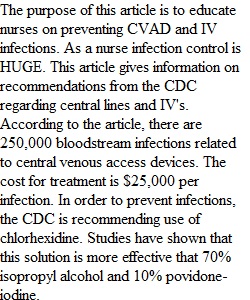


Q Article Critique: Discussion Question Requirements: • Access an article from a journal listed below. When examining the nursing research article discuss the following: • Identify if article has a review of literature. • Determine the purpose of the article. • Describe how information in your article can be implemented into your nursing practice? • Provide your rationale for using this information in nursing practice? • Post the name of the article in APA format along with your responses to the critique questions. • Post your initial post by day 3. Obtain and critique an article from one of the following journals. a. AJN: American Journal of Nursing (coverage beginning January 1996) b. Home Healthcare Nurse: The Journal of the Home Care and Hospice Professional (coverage beginning January 2000) c. Nursing: The Peer-Reviewed Journal of Clinical Excellence (coverage beginning January 2002) d. Nursing Critical Care: The Journal of Critical Care Excellence (coverage beginning January 2006) e. Nursing Made Incredibly Easy! (coverage beginning September/October 2003) _________________________________________________________________________________________________________________________ Discussion Requirements This discussion forum requires that the student create an initial post before being able to see other student posts. Once you make your first post, your classmates’ posts will appear and you can respond as directed below. Students must first post a topic before they are allowed to view or reply to other student’s posted topics. Your initial response should be posted no later than midnight on Day 3. Then post 2 responses to peers on two additional days during the week. The minimum participation is 3 posts (initial + 2 responses) on 3 different days. Your input should be in your own words, demonstrating your understanding, and comprehension of the topic. Information used when formulating your initial post will be from professional nursing journals and/or professional websites. Wikipedia is not a professional website. Using your own experience and personal knowledge is not acceptable when answering initial discussion posts. Spell check all posts. Cutting/pasting or copying word for word from resources will not be tolerated. Use APA format for in-text citations and references. Responses to peers will be substantive and not just “Thanks” “I agree” “Nice post” and such. One word or one or two sentences is not a substantive response. Responses should be thorough, offer some sort of new insight or reasoning, or offer critical or analytical thought. You need an overall discussion average of 74% to pass this course. A grade of 0 will be earned for each week a student does not post. Late submissions will not be accepted for grading. Any submissions outside of the assigned unit week will not be counted. Bottom Line: Be sure to at least meet the minimum posting requirements...you cannot just log in, post one day and be done. You are not required to reply to everyone, but to read all posts during the weekly discussion. I am primarily looking for quality posts that further the discussion. Think of this as a discussion we may have in the classroom setting, except we are doing it online over the course of a week. If you have questions about this participation requirement, post them to the Course Q&A Discussion Refer to the Course Syllabus and Discussion Grading Rubric prior to submitting posts, to ensure that your posts are submitted according to the rubric.
View Related Questions